Effective link-building strategies are essential for businesses to stay ahead in organic search engine rankings. With a dynamic digital environment and ever-changing algorithms, crafting a successful link-building strategy has become an art as much as a science. This comprehensive guide delves into proven tips for garnering more backlinks, exploring innovative techniques and best practices, and providing clear-cut examples to elevate your SEO game. Are you ready to revolutionize your online presence? Keep reading to discover the secrets of 2024’s top-performing link-building strategies!
What are link-building strategies?

Link-building strategies are methods and tactics that website owners or marketers employ to acquire high-quality inbound links (also known as “backlinks”) from other websites. These specific approaches enhance their site’s visibility in search engines like Google, resulting in increased traffic and improved authority within their niche.
A solid link-building strategy’s ultimate goal is obtaining more inbound links and ensuring they come from reputable sources. The best sources are websites with high domain authority reflecting expertise and credibility that will positively impact your authority score. Implementing well-thought-out linking plans lets you fortify your site’s legitimacy and improve its ranking on search engine results pages (SERPs), ultimately leading to higher brand exposure and customer engagement.
What are the key elements of a successful link-building strategy?
A successful link-building strategy requires thoughtful planning and execution to produce positive results. Here are the key elements that contribute to an effective link-building campaign:
- Objective setting: Setting specific goals for your campaign is vital before embarking on any linking endeavor. Objectives include increasing organic search traffic, improving brand visibility, or enhancing domain authority.
- Quality Content: High-quality, original content acts as a magnet for attracting users and backlinks. This includes producing engaging articles, infographics, and multimedia content that appeals to your target audience.
- Targeted outreach: Reaching out to relevant industry influencers, bloggers, and web admins can help build relationships that lead to quality backlinks. Personalized outreach emails can significantly impact securing guest blogging opportunities or collaborations with high-domain authority websites.
- Relevance: Ensuring that obtained links come from relevant and authoritative sources helps search engines associate your website with the linked pages’ topical niches. This improvement in contextual association boosts both organic search rankings and overall credibility within your field.
- Diversification of Backlinks: It’s crucial not to rely on just one approach when crafting your link-building strategies. Incorporating diverse tactics like guest blogging, resource page placements, or broken link replacements will result in a more natural-looking backlink profile.
- Link reclamation: Actively monitoring for lost links presents an opportunity to recover existing backlinks pointing to modified URLs or removed content on your site.
- Competitor analysis: Regularly studying competitors’ backlink profiles allows you to discover new opportunities for obtaining backlinks while staying attuned to shifting trends within your industry.
- Measurement & Evaluation: Success is best determined by regularly assessing progress against initial objectives using Key Performance Indicators (KPIs). Standard metrics include Domain Authority (DA) growth, keyword rankings improvement, and overall website traffic increases.
- Consistency: Link building is not a one-time effort; remaining consistent in your approach helps to establish long-term success as the competitive landscape evolves.
- Adaptability: SEO algorithms change frequently, so it’s crucial to stay informed of industry updates and be prepared to adjust strategies accordingly for sustained growth and effectiveness.
Incorporating these vital elements within your strategic planning will lead to a comprehensive link-building strategy that drives tangible results for organic search performance, brand visibility, and domain authority growth.
93.8% of link builders say link quality is more important than link quantity. This statistic emphasizes the importance of focusing on high-quality, relevant backlinks rather than simply aiming for a high number of links.
What is the difference between link-building strategies, tactics, best practices, and techniques?
To fully comprehend effective link-building strategies for SEO, it is essential to understand the distinctions between link-building strategies, tactics, best practices, and techniques. By differentiating these terms, you will be better equipped to create a tailored and successful approach to your link-building efforts.
Link Building Strategies
A link-building strategy is an overarching plan designed to achieve specific objectives – such as increasing website traffic, improving domain authority, or enhancing brand visibility – through acquiring new backlinks from other relevant websites. This high-level roadmap includes defining specific goals, determining target audiences, identifying potential opportunities for building links, and outlining outreach methods for attaining those links. Examples of popular link-building strategies include content creation and promotion, guest blogging, or infographics.
Link Building Tactics
While a strategy serves as the general direction and purpose for your link-building efforts, tactics are the actual actions taken within that strategy to achieve desired results. These practical initiatives can range from search engine optimization (SEO) efforts like targeting specific keywords appearing on authoritative sites or digital PR activities like securing traditional mentions by working with industry influencers or journalists. The identification of suitable tactics depends on the overall link-building strategy.
Link Building Best Practices
Best practices refer to recommended guidelines derived from proven track records of success in achieving intended outcomes. In the context of link building, these would be tried-and-tested approaches known for yielding positive effects when undertaking a linking endeavor. Adhering to these widely accepted standards assures greater efficacy in producing desirable outcomes while minimally risking penalties from search engines.
Examples of well-known link-building best practices include:
- Crafting unique and shareable content,
- Reaching out to reputable prospects within your niche,
- Establishing clear communication with prospective partners,
- Aligning SEO metrics/data analysis regularly.
Link Building Techniques
Techniques constitute specialized ways or specific skill sets employed within the chosen tactics to bring about desired effects, keeping in mind the adherence to prescribed best practices. These refined skills are helpful for the execution of relevant tactics and allow for targeted success with your link-building approach. Some common techniques used in SEO include:
- Anchor text optimization,
- Utilizing PR and media outlets,
- Contextual and localized outreach,
- Leveraging social influence.
By clearly differentiating between strategies, tactics, best practices, and techniques in link-building endeavors, you can establish a solid foundation from which to develop a comprehensive linking plan that boasts precise goals, carefully chosen actionable steps as per industry guidelines– all supported by specialized expertise aimed at achieving optimal results.
Types of Backlinks
When it comes to link-building strategies, understanding the different types of backlinks is crucial. Each type serves a specific purpose and holds varying importance in search engine optimization (SEO). This section will outline three primary categories: DoFollow links, NoFollow links, and Internal links.
DoFollow Links
DoFollow links are the most sought-after backlinks when implementing link-building strategies for SEO. These standard hyperlinks allow search engines to follow them, passing valuable “link juice” to your website. This means they impact your site’s rankings and authority within search results.
Some common methods of obtaining DoFollow links include:
- Guest blogging on relevant websites
- Creating high-quality content that naturally attracts inbound links
- Participating in interviews or podcasts
- Building relationships with influencers in your niche
Search engines view these organic DoFollow links as votes of confidence for your website from other credible sources. Therefore, they significantly boost your domain’s authority and improve its appearance in search results.
NoFollow Links
NoFollow links differ from their DoFollow counterparts. However, clickable by users, they don’t transfer any SEO benefits to the linked site. Essentially, a rel= “nofollow” attribute tells search engines not to consider them as part of their ranking algorithms.
Despite this limitation, NoFollow links still carry some value for businesses engaging in link-building techniques:
- They can generate referral traffic from users clicking through the link.
- You create a more natural-looking and diverse backlink profile by maintaining a mix of DoFollow and NoFollow backlinks.
Examples of sources for NoFollow links include blog post comments, forum posts, and social media platforms like Twitter and Pinterest – where web admins cannot directly control which sites are linked.
Internal Links
While obtaining external backlinks is essential for successful link-building strategies, pay attention to the significance of interconnecting pages within your website. Internal links are backlinks that connect one page of your site to another, establishing a hierarchy and improving user navigability.
A well-structured internal linking strategy serves vital functions such as:
- Providing context and relevance to search engines can lead to better indexing and understanding of your content,
- Enhancing user experience by guiding them through the website seamlessly,
- Boosting the visibility and authority of your lesser-known pages.
Using descriptive anchor texts that indicate the linked content is essential.
42% of SEO professionals spend equal time building internal and external links. This highlights the importance of balancing both internal and external link-building efforts in a comprehensive SEO strategy.
Understanding these three types of backlinks is integral to crafting robust link-building strategies, allowing you to create a proper balance between each type. Focus on obtaining DoFollow links for SEO validation while incorporating NoFollow and internal links to maintain diversity within your digital presence.
Strategy 1: Content Creation and Promotion [with Example]
Content creation and promotion are at the core of effective link-building strategies. By producing high-quality, engaging content that provides value to your audience, you can attract natural backlinks from other websites in your industry. Educational material like How-to Guides and Tutorials is one type of content that performs exceptionally well in generating valuable backlinks.
Blog posts, How-to Guides, and Tutorials
How-to Guides and Tutorials provide step-by-step instructions for solving everyday problems or learning new skills related to a specific subject area. They cater to readers who need practical, actionable information, making these resources highly shareable and link-worthy.
To be successful with this strategy, consider the following tips:
- Focus on a specific topic: Choose a niche subject within your industry with a demand for practical knowledge but a limited supply of easy-to-understand guides.
- Make it comprehensive: Cover all necessary steps or aspects of the process so readers don’t need to search elsewhere for additional information.
- Incorporate visuals: Include images, screenshots, or even video tutorials alongside written explanations to enhance understanding and engagement.
- Format properly: Organize content into clear sections with headings, subheadings, bullet points, or ordered lists for easy navigation.
- Optimize for SEO: Use relevant keywords naturally throughout the guide while maintaining quality content and readability.
Successful Example: Moz’s Beginner’s Guide to SEO
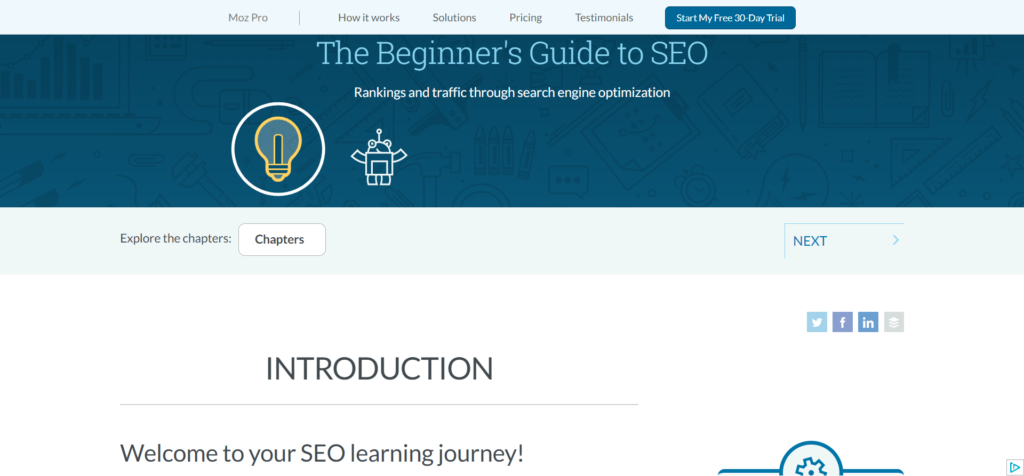
A notable example of a successful how-to guide is Moz’s Beginner’s Guide to SEO. This comprehensive resource covers all search engine optimization (SEO) aspects, so users don’t need prior knowledge about the subject before reading it.
The guide has been widely praised for its depth, clarity, visual design elements, and organization – complete with easily navigable chapters and specific topics. As a result, Moz’s Beginner’s Guide has earned backlinks from countless authoritative websites in the marketing and SEO industry.
To leverage content creation and promotion as a link-building strategy, identify valuable knowledge gaps within your niche that you can address with How-to Guides or Tutorials. Then, create comprehensive and engaging resources that benefit your target audience, making them more inclined to share and link back to your content on their platforms.
Strategy 2: Guest Blogging [with Example]

Guest blogging, or guest posting, is an effective link-building strategy where you write content for other websites within your niche or industry. Submitting high-quality articles to these sites allows you to leverage their established audience and authority to obtain backlinks and drive more traffic toward your own website.
Steps to Follow in Guest Blogging
- Identify authoritative websites or blogs in your niche.
- Research their audience demographics and interests for a well-targeted article topic.
- Pitch your ideas to the site owner or editor with a personalized proposal.
- Write the guest post while following editorial guidelines and linking to relevant content on your website.
- Promote the published article on social media platforms.
Key Benefits of Guest Blogging
- Drive targeted referral traffic,
- Build brand awareness,
- Obtain high-quality do-follow backlinks,
- Gain new connections in your field,
- Improve credibility and expertise.
Tips for Effective Guest Blogging
To maximize the impact of this link-building technique, make sure to:
- Focus on quality: Produce top-notch articles showcasing knowledge in your field to leave a lasting impression on new readers and the host site’s regular audience.
- Target relevant websites: Ensure potential partners cater to audiences interested in your service or product offerings.
- Stay consistent: Reach out to multiple websites since success rates may vary, and make guest posting a constant part of your link-building strategy.
- Engage with the host website’s audience after publication: Respond to comments and join conversations to demonstrate your expertise further and build relationships.
By incorporating these tips into your guest blogging efforts, you can accumulate valuable backlinks, expand your network, and boost credibility within your niche.
Apart from guest posting, Georgi Todorov from Create&Grow mentions other effective blogger outreach tactics, such as product reviews, giveaways, or link partnerships.
Successful Example: Buffer’s Rise Through Guest Posts
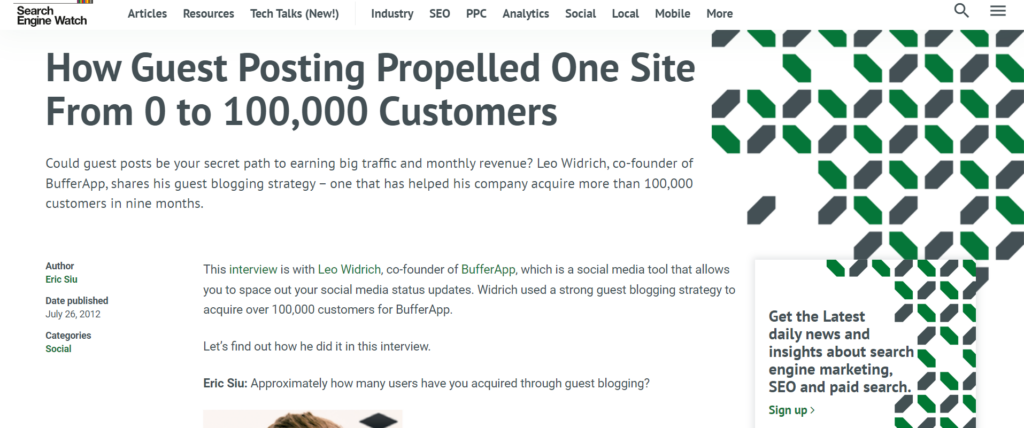
Buffer, a popular social media management tool, used guest post blogging as one of its core strategies during its initial days, accelerating its growth significantly (Source: SearchEngine Watch). Leo Widrich, the co-founder of Buffer, wrote around 150 guest posts within nine months that generated over 100,000 users.
Mind that only 8.5% of link building cold emails yield results. This statistic highlights the importance of persistence and quality in outreach efforts for guest blogging and other link-building strategies.
Strategy 3: Infographics and Visual Content [with Example]
Visual content has always been effective in capturing the attention of the audience. With infographics, Slideshare presentations, charts, graphs, drawings, and illustrations, your website has a higher chance of obtaining valuable backlinks from authoritative sites. These various forms of visual media not only please the eyes but also make it easier for users to understand complex information. Incorporating innovative and appealing visuals into your link-building strategy can generate shares, increase user engagement and earn quality backlinks.
Slideshare Presentations
Slideshare is an online platform allowing users to share their PowerPoint presentations, infographics, PDFs, or other visual content. It has become one of the leading platforms for professionals to showcase their expertise in various fields while assisting others in understanding complex topics more efficiently.
Creating informative Slideshare presentations relevant to your industry or niche and embedding them within your blog posts or articles makes you more likely to receive backlinks from related websites. A strong emphasis on high-quality visuals accompanied by valuable information is critical here.
Charts and Graphs
Incorporating charts and graphs into your website content is another effective link-building strategy that provides viewers with a visually pleasing way to digest data-driven insights. These eye-catching visuals present otherwise overwhelming data in an easy-to-understand format that caters to beginners and experts.
Originality is essential when designing unique charts or graphs based on industry-specific research or data sets. Remember that by illustrating exclusive data insights, you significantly improve the chances of attracting links from authority sites in your niche.
Drawings and Illustrations
Custom illustrations or drawings are another effective methods to convey complicated information visually compellingly, gaining user attention quickly. When embedding original artwork or illustrations within your website’s content, you demonstrate an additional layer of creativity and further set yourself apart from competitors by attracting high-quality backlinks.
However, it is essential to remember that these illustrated images must remain aligned with your brand image while effectively supporting the subject. Employing skilled designers or commissioning professional artists will serve you best in producing relevant yet engaging visual representations of your message.
Successful Example: Moz’s Whiteboard Friday
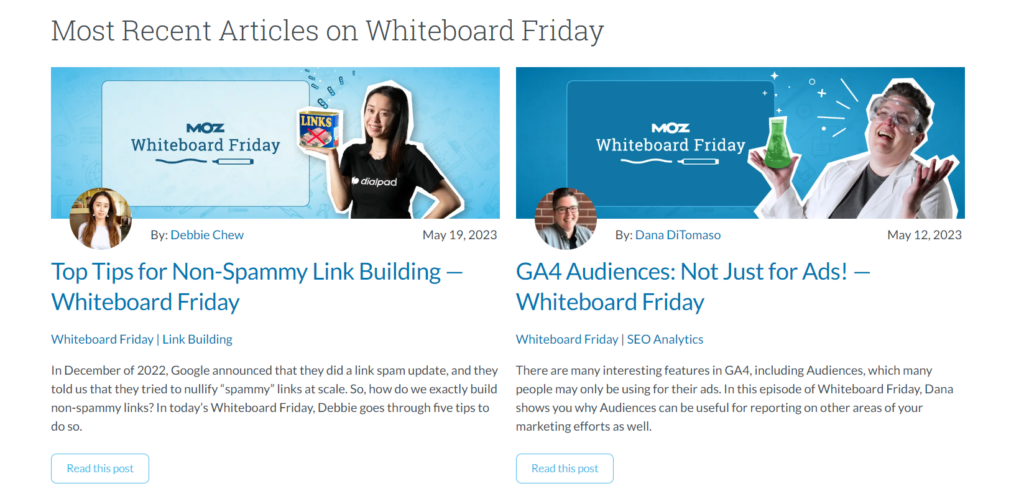
Moz’s Whiteboard Friday sessions are an iconic example of successful link-building strategies involving custom drawings and illustrations. Their weekly educational videos, presented on a white backdrop featuring hand-drawn visuals, have earned numerous shares and quality backlinks due to their accessibility and superior effectiveness in explaining complex SEO topics.
Leveraging AI-powered content collaboration can enhance your visual content strategy. AI tools can help identify potential collaboration partners and create unique, data-driven visual content that naturally attracts high-quality backlinks.
Strategy 4: Resource Pages [with example]
Resource pages are web pages that curate and list valuable resources and links within a specific industry or topic. One of the best link-building strategies to boost your SEO ranking is to include your website on such resource pages.
Why Resource Pages Work as Link-Building Strategy
There are several reasons why leveraging resource pages can be beneficial for your website:
- Relevance: These pages usually include high-quality, relevant content related to your niche, making it more likely you’ll earn a backlink from an authoritative source.
- Trust: A recommendation from an expert in your field often carries significant weight with readers, increasing confidence in your brand and encouraging further engagement.
- Outreach Potential: Most resource pages willingly add more premium material, which makes it easier to establish relationships with website owners through personalized outreach.
Resource page strategy implementation
To implement this strategy effectively, consider these steps:
- Conduct research using search queries like “your industry + resources” or “your niche + useful links” to find relevant resource posts within your area of expertise.
- Analyze each page’s authority using tools like Moz’s Domain Authority checker or Ahrefs’ Domain Rating tool.
- Reach out to each web admin or editor responsible for these Link building strategies resources with a tailor-made email that clearly explains the benefits of linking back to your website while offering value in return (e.g., sharing their link on social media).
- Be persistent, professional, and engaged in your outreach efforts. Building relationships often facilitates future link-building maneuvers.
Develop industry-specific microsites as comprehensive resources for specific topics within your industry. These sites can attract links from a wide range of sources and can be internally linked to your main site, passing authority and improving your overall link profile.
Successful Example of Leveraging Resource Pages
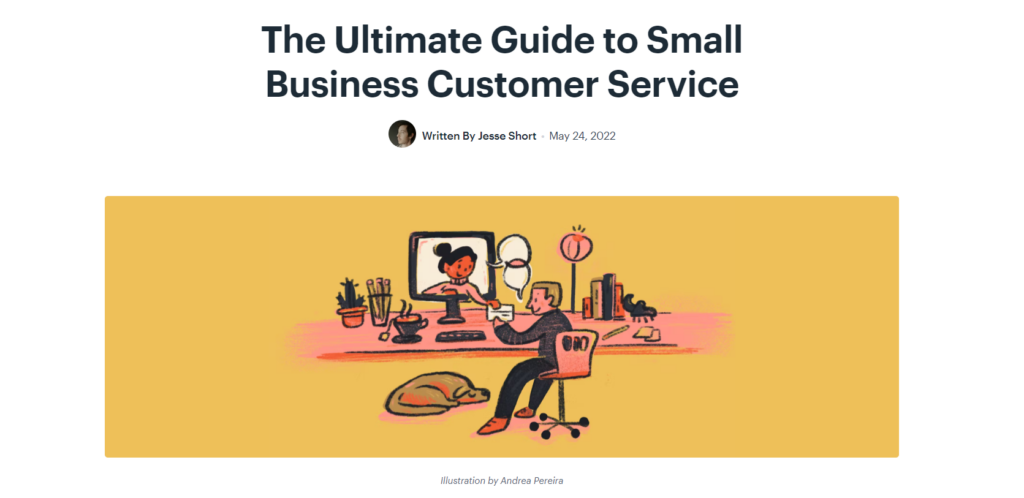
Take Help Scout, a customer service platform provider, as an example. They created The Ultimate Guide to Small Business Customer Service – a comprehensive guide filled with valuable tips and resources on improving business customer support services. By reaching out to websites running resource pages focusing on this topic, they secured numerous high-quality backlinks that boosted their online presence and overall SEO rankings.
Strategy 5: Broken Link Building Strategy

Broken link building is a highly effective SEO strategy that involves identifying broken or dead external links on relevant, high-quality websites and suggesting your content as a replacement. This helps you establish new backlinks and adds value to the website owner by fixing damaged or dead links.
Reclaim Links Pointing To 404s
One key aspect of implementing this strategy is reclaiming lost or broken links pointing to your website’s non-existent (404) pages. To successfully execute this method, follow these steps:
- Identify broken inbound links: Utilize reliable tools such as Google Search Console, Ahrefs’ Site Explorer, or Screaming Frog to discover any broken inbound links currently directing users to 404 pages on your own site. Make a list of these URLs for further analysis.
- Evaluate content relevance: Analyze the originating page with the broken link(s), and determine if the previous content you were linking to is still valuable and relevant.
- Restore or redirect: If possible, restore the original content that earned those backlinks in the first place; otherwise, create new, high-quality content that accurately replaces it. Alternatively, you can redirect (using permanent 301 redirects) the broken URLs to existing related resources on your site.
- Outreach: Politely inform webmasters about their broken inbound links. Mention their specific URL and propose an updated link connecting to previously restored or newly created content.
Utilize “broken link building” with a twist: Instead of just finding broken links and suggesting your content as a replacement, create a superior, updated version of the original broken resource. This approach not only helps you secure the link but also positions your content as the go-to resource for that topic, potentially attracting additional links organically
You can also exploit “link reclamation” opportunities by using advanced tools to identify mentions of your brand, products, or key personnel across the web that don’t include a link. Reach out to these sources and request that they add a link to your site. This strategy capitalizes on existing brand awareness and can quickly increase your backlink count.
Strategy 6: Personal Branding and Networking [with Example]
Personal branding and networking are pivotal in executing effective link-building strategies. By establishing authority within your niche and forging solid relationships with other industry professionals, you can ultimately generate valuable backlinks to your website.
Ask People You Know for Links
One of the most natural ways to build links is by contacting your existing network. Whether it be friends, family, colleagues, or professional acquaintances, who are active in your industry or a closely related field, these connections can offer an excellent opportunity for generating backlinks. Consider these tips when asking people you know for links:
- Research their websites beforehand to ensure relevance and quality.
- Prepare personalized outreach messages that emphasize mutual benefit.
- Offer them a linkable resource that is genuinely valuable for their audience.
- Follow up respectfully if there’s no response initially.
A successful real-life example of this approach comes from Neil Patel, leading marketing expert and co-founder of CrazyEgg and Kissmetrics. He built his brand using his blog and social media platforms like LinkedIn and Twitter. As his reputation grew within the digital marketing space, he was able to leverage his network for guest post opportunities and high-quality backlinks, driving substantial traffic to his sites.
Ask Customers
Your existing customers can also be an invaluable source of potential backlinks. Depending on the nature of your business, consider reaching out to customers who have expressed satisfaction with your product or service offerings and encourage them to write reviews or testimonial content featuring links back to your site:
- Identify delighted customers who may have a reputable online presence.
- Reach out personally with custom messaging thanking them for their support.
- Provide guidelines or suggestions on how they might incorporate a helpful link back to your site in their review or testimonial content.
- Offer ongoing assistance or incentives (discounts, exclusive content, etc.) for their continued engagement with your brand.
A classic example of successfully leveraging customer relationships for link building is Warby Parker, an online eyewear retailer (Source: Spyfu). The company adopted a unique home try-on program approach. It encouraged customers to share their experiences across social media channels and on their personal blogs. As a result, the brand received numerous organic backlinks from satisfied users, generating considerable buzz and boosting search engine rankings.
Strategy 7: Competitor Analysis
One of the most effective link-building strategies is to analyze your competitors. By examining their online presence, you can identify opportunities for growth within your own business and discover the best ways to get ahead in 2024. One key area to explore is their backlinks when conducting a competitor analysis. Understanding how, why, and where your competitors get backlinks can help you develop and refine your linking strategy.
Check Competitors’ Backlinks
To successfully examine your competitor’s backlink profile, follow these steps:
- Identify relevant competitors: List websites within your niche with similar or higher authority than yours. These will be the sites you’ll analyze to gain valuable insights.
- Use backlink analysis tools: There are several helpful tools available for checking backlinks, such as Ahrefs, Moz’s Link Explorer, Semrush, and Majestic SEO. These platforms offer comprehensive data on the quantity and quality of backlinks pointing toward any website.
- Analyze backlink quality: Once you’ve collected data on your competitor’s backlinks using these analytics tools, it’s essential to delve deeper into understanding the quality of these connections by looking at various factors such as:
- Domain Authority (DA) and Page Authority (PA): Refers to a site’s perceived importance or credibility based on its online performance.
- Anchor text: The clickable text used in a hyperlink often plays a vital role in search engine rankings. Therefore, examining how your competitors employ anchor texts is critical.
- Relevancy: Always precede links from sites related directly or indirectly to your niche or industry since they hold more weight.
- Compare tactics: After scrutinizing different aspects of your competitors’ link-building techniques and practices, compare them against those you employ. It will help you garner valuable insights to improve your strategy and outperform your rivals.
- Adapt and implement: Based on the above comparisons, adapt successful link-building strategies from your competitors and incorporate them into your plan.
By thoroughly analyzing competitor backlinks, you can gain vital information that aids in optimizing your approach towards link building. Moreover, checking competitors’ backlinks can reveal potential industry gaps or innovative ways of acquiring prospects’ links. In essence, competitor analysis forms an integral part of a comprehensive link-building strategy explicitly catered to meet the demands of 2024’s competitive digital landscape.
Strategy 8: Link Roundups [with Examples]
Link roundups are a powerful link-building strategy that can significantly boost your website’s visibility by accumulating valuable backlinks. They are curated content, blog posts or articles, that collect and share high-quality resources on specific topics from various sources in one location.
Best Tools Lists
One common form of link roundups is “best tools lists,” where you compile a list of top-notch, relevant tools for your target audience. When executed well, these lists can become popular resources within industry circles, providing immense value to users seeking reliable solutions.
For instance, we published an article titled AI Content Writing Tools – The Best of 2024, which is an essential resource for professionals looking for practical SEO tools.
List of Stats
A statistics roundup creates compelling content by compiling research findings, data points, or numerical facts related to a specific subject matter relevant to your niche. These numbers paint a bigger picture of the topic and offer informative insight to readers.
We published a comprehensive list of 100+ Latest Content Marketing Statistics for 2024 containing impressive marketing stats from various surveys and studies worldwide.
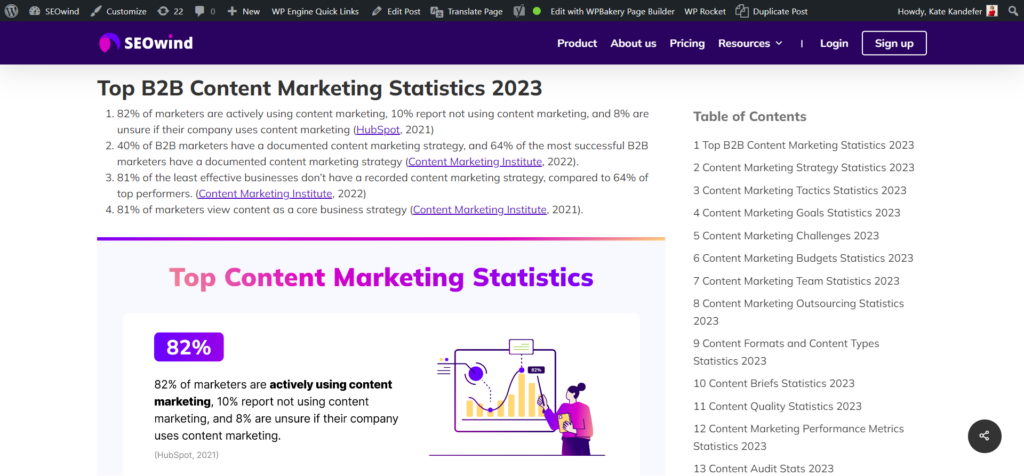
Podcasts Lists
As podcasts continue gaining popularity in today’s digital landscape, creating podcast lists catered specifically to your niche could be another effective way to secure quality backlinks. This involves showcasing some excellent podcasts that resonate with what your audience wants.
Email People / Tools That You Mention
Once you’ve published your link roundup, reaching out to the people or resources you’ve mentioned within your compiled lists is crucial. Inform them you’ve included their content/tool/podcast and share the link. This approach not only sparks networking opportunities but could also result in these individuals sharing the roundup with their audience or linking to your content as a gesture of appreciation.
Mastering link roundups goes beyond merely adding links to resources; it involves selecting quality material that directly benefits your target audience and accelerates organic growth through networking and relationship-building efforts. By focusing on delivering exceptional value that solves real problems, there’s no doubt that this strategy will attract numerous backlinks to your website while simultaneously establishing your authority within your niche.
Strategy 9: Tracking Your Backlinks
In the world of link-building, knowledge is power. The more you know about your backlinks, the better equipped you are to make informed decisions and improve your SEO strategy. With this in mind, let’s discuss why tracking your backlinks is crucial and how to do it effectively.
Why Track Your Backlinks?
Tracking your backlinks is essential for several reasons:
- Identify Valuable Sources: By monitoring where your backlinks are coming from, you can identify websites that provide valuable links, resulting in higher search rankings and increased authority.
- Discover Potential Partnerships: Link building often relies on good relationships between content creators; by identifying sites that are already organically linking to you, potential partnerships or collaborations may arise.
- Detect Negative SEO Attacks: Keeping an eye on your backlink profile allows early identification of unethical methods against your site (e.g., spammy links imposed by competitors), so you can take defensive measures accordingly.
- Measure Progress Over Time: Tracking helps assess the effectiveness of current link-building strategies and offers insights for future optimization based on data-backed trends.
Tools for Backlink Monitoring
Several tools can assist in monitoring and evaluating backlinks:
- Google Search Console: This free tool provided by Google comes with a comprehensive “Links” section showing external sources pointing to your website, along with internal linking information.
- Ahrefs Site Explorer: A powerful yet user-friendly paid option; use Ahrefs to study the link profiles of any domain – yours or competitors’.
- Moz Link Explorer: This subscription-based tool provides insight into brand influence based on domain authority, page authority, spam scores, and other vital factors.
How Often Should You Check?
Regularly check your backlink profile. Weekly or bi-weekly audits are recommended for fast-changing industries or dynamic websites. A monthly check should suffice for smaller or static websites, but remember that search engines love fresh and updated content.
Strategies for Monitoring Your Backlinks
- Set up Google Alerts: By creating unique alerts with relevant keywords, you will receive notifications whenever new links mention your brand or target keyword.
- Review Referral Traffic in Analytics: Check which sites are sending organic traffic to your domain and identify if any need further evaluation from a backlink perspective.
- Track Competitor Backlinks: Besides monitoring your backlinks, remember to compare against competitors, as their strategies might inspire or inform your approach.
Tracking your backlinks is essential to any link-building strategy. It helps you protect and strengthen your SEO efforts. It opens doors for collaborations and improved practices based on meaningful data. Use various tools available to stay informed and make strategic decisions about where to focus future link-building campaigns.
Strategy 10: Content Pillars [with Example]

Content pillars are an essential component of a robust link-building strategy. This approach revolves around creating comprehensive, authoritative content that covers specific topics in-depth while serving as a foundation for your website’s structure and future content creation. By developing these cornerstone resources, you can attract high-quality backlinks from relevant sources, position yourself as an expert within your industry, and improve your SEO rankings.
Characteristics of Effective Content Pillars
To make your content pillar stand out and become link-worthy, ensure it possesses the following attributes:
- Comprehensive coverage: In-depth exploration of a particular topic should include various aspects, subtopics, and possible questions that users may have.
- Well-organized structure: Easy navigation is crucial to keeping readers engaged. Employing headings, subheadings, bullet points, ordered lists, and visual aids helps with this aspect.
- High-quality information: Delve into reliable research and data to support your content’s arguments.
- Usability with actionable tips or advice
- Regular updates that keep the resource current
Integrating Content Pillars Into Your Link-Building Strategy
To seamlessly integrate content pillars into your link-building strategy, consider the following steps:
- Identify topics of high interest or demand in your specific industry.
- Research existing resources to uncover gaps you can fill with your unique insights and data.
- Develop an outline for your content pillar that delves deep into the topic and addresses its various aspects.
- Design attractive visuals that enhance information clarity and appeal.
- Publish, promote, and monitor the content’s performance for areas of improvement
- Keep the resource updated and relevant.
By implementing content pillars within your strategic arsenal, you strengthen your link-building capabilities and overall SEO performance, brand authority, and user engagement on your website.
Successful Example: Backlinko’s Definitive Guide on Link Building
One prime example of a successful content pillar is Backlinko’s Definitive Guide on Link Building. It covers virtually every aspect related to link-building strategies for SEO purposes. This guide has established itself as a go-to resource within the industry.
Some factors contributing to its success include:
- Extensive information is broken down into well-defined sections,
- Visual components like images, charts, and illustrations aid reader comprehension,
- Actionable tips are provided throughout the guide,
- Continual updates are reflecting industry changes.
This comprehensive guide has generated numerous organic backlinks because other websites recognize the value it provides their readers when they reference specific sections or recommend it as an outstanding source.
Strategy 11: Social Mentions

Leveraging social mentions is an effective link-building strategy that can aid in increasing your online visibility and generating high-quality backlinks. By monitoring, engaging with, and capitalizing on conversations involving your brand, industry, or niche on social media platforms, you can foster relationships and tap into opportunities for driving organic traffic to your website.
What are Social Mentions?
Social mentions are instances where users mention or discuss your brand, products, services, or related topics on various social media channels such as Facebook, Twitter, Instagram, LinkedIn, and Pinterest. These discussions may involve multiple formats, including text-based posts, images, videos, or shared links from third-party sources.
How Social Mentions Help Link Building
The process of utilizing social mentions to build backlinks involves several activities:
- Monitor: Use tools like Mention and Google Alerts to track relevant keywords across social media channels, such as your brand name or industry-related terms. This helps in identifying relevant conversations and staying up-to-date with trends.
- Engage: Actively participate in the conversations by responding to comments and questions about your brand or niche. It’s essential to provide value-add responses that contribute positively to the discussion without sounding too promotional.
- Create Opportunities: When you come across users who have expressed interest in learning more about a topic related to your field of expertise or product offerings- consider reaching out directly in hopes of sparking engagement further by sharing additional resources with them—such as blog posts from within your website that help answer questions/topics they’re interested in.
- Share Your Content: Share valuable content on your website in relevant spaces. Others may cite it as a source and generate natural backlink opportunities. They will appreciate the content shared by your business.
- Develop Relationships: Building relationships with key players in your industry using social platforms can lead to organic backlink opportunities. Network with influencers and professionals related to your niche, share their content, and engage meaningfully in their posts.
- Collaborate Partnering with other brands or influencers in creating unique content that caters to shared audiences between both parties involved would be beneficial all-around, ultimately giving further incentive/engagement/link-building possibilities for everyone as a result of successful collaborations formed initially through social media efforts made leading up until then.
Strategy 12: Editorial Links
Editorial links are a vital yet often overlooked form of link-building strategy. You can obtain these credible and authoritative backlinks when reputable and trustworthy websites reference your content naturally, leading their audience to your site. The credibility factor makes editorial links so prized within the SEO industry.
Understanding Editorial Link Building
A few key elements that contribute to achieving these valuable connections include:
- High-quality content: Ensure that the information you offer is not only captivating but accurate as well.
- Relevance: Write on topics related to your niche that online publications may be interested in linking to.
- Building relationships: Network with influencers, opinion leaders, and journalists who can amplify your voice by sharing or referencing your content.
Utilizing Credible Examples & Data
When providing insights or analyses within your content pieces, using examples and citing data from credible sources increases trustworthiness dramatically. Demonstrating expert-level knowledge in your area will encourage others within the niche to share and utilize it as an authoritative resource.
Strategy 13: Be Specific With Your Outreach [with Example]
The key to a successful link-building strategy is often specificity in your outreach. You can significantly increase the chances of receiving backlinks by tailoring your communication with influencers, website owners, or relevant industry partners. In this section, I will discuss the importance of being specific with your outreach and provide an example of a successful approach.
Importance of Specificity in Link Building Outreach
When reaching out to others for potential backlinks, it’s crucial to keep these points in mind:
- Understand their content: Do thorough research on the content they produce and find a mutual interest where both parties can benefit from collaboration.
- Personalize your message: Pouring attention into crafting personalized messages helps establish clear intentions and creates rapport.
- Communicate value: Illustrate how your content could complement theirs while providing additional value to their audience.
Paying close attention to these details demonstrates respect, authenticity, and genuine interest in collaborating with the individual or organization.
Successful Example: Blogger Collaboration
Let’s say you have published an ultimate guide on sustainable fashion brands that comprehensively lists eco-friendly clothing options. You want to get it noticed by a larger audience and build links from influential websites within this niche.
In this case, you could identify authoritative bloggers who frequently write about sustainable living but need more comprehensive resources on eco-friendly clothing options.
Once you have identified such bloggers, proceed with a well-crafted email that refers specifically to their work on sustainability while also pointing out their lack of extensive resources concerning environmentally conscious clothing choices. Your message should demonstrate how linking to your helpful resource would enhance their existing content and benefit their readers’ quest for sustainable fashion brands.
For instance:
Subject: Collaboration Idea: Adding Value To Your Sustainable Living Content
Hi [Blogger’s Name],
I sincerely appreciate your dedicated work toward promoting sustainable living through your blog [Blog Name]. I recently read your article on minimalism and found it insightful.
I noticed that you have written about eco-friendly clothing options in the past. Still, the information is scattered across various articles. To support this cause, I have published an ultimate list of sustainable fashion brands to help environmentally conscious individuals make informed choices.
By linking to my resource, your readers will gain access to a comprehensive guide for shopping sustainably, further reinforcing the values you share on [Blog Name].
Here’s the link to my “Ultimate Guide.
Thank you for considering this collaboration opportunity. Please let me know if you have any questions.
Best regards,
[Your Name]By carefully researching your target blogger, addressing their needs, and underscoring how incorporating your link would add value for their audience and their blog content, you increase the likelihood of obtaining high-quality backlinks.
Strategy 14: Be Active on Q&A Sites
One of the most effective link-building strategies to gain valuable exposure and backlinks is actively participating in question-and-answer (Q&A) sites like Quora, Yahoo Answers, and Stack Exchange. These platforms not only provide opportunities to create natural backlinks but also allow you to showcase your knowledge and expertise within your industry. This section discusses how being active on Q&A sites can significantly contribute to your link-building strategy.
The Benefits of Participating in Q&A Sites
Active participation in Q&A sites has several advantages for your link-building and overall online presence:
- Demonstrates Your Expertise: By answering questions related to your niche, you can establish yourself as an expert within your field. This can boost your credibility and reputation among users seeking information or expert advice.
- Increases Exposure: As people continue to seek answers on these platforms, providing helpful information that directly addresses their concerns contributes positively towards creating a better brand image.
- Drives Targeted Traffic: Users who find value in your responses may likely click through the backlink attached to visit your website for further insights or resources, resulting in targeted traffic that could convert into leads or customers.
- Builds Quality Backlinks: Sharing informative content with relevant links on high-authority websites such as Quora can help strengthen your site’s off-page SEO performance.
Tips for Successfully Engaging on Q&A Sites
To derive maximum benefits from engaging on Q&A sites while adhering to link-building best practices, consider these key points:
- Choose the Most Relevant Questions: Search for questions closely aligned with your expertise or solutions, ensuring you accurately address the concerns raised.
- Deliver Practical Solutions: Focus on providing value-added responses rather than simply quoting facts; explaining practical applications earns higher user appreciation.
- Avoid Oversaturating Your Answer with Links: Keep your answers natural and not overly promotional by limiting the number of backlinks. Include links only when they genuinely contribute to answering the question.
- Optimize Your Profile: Create a complete and up-to-date profile with relevant details about your professional experience to increase trust among users visiting your profile.
Strategy 15: Glossary of Industry Terms
Creating a comprehensive glossary of industry terms is an excellent link-building strategy that helps establish your authority in the niche and attracts high-quality backlinks to your website. By providing clear and concise definitions of jargon, acronyms, or complex concepts within your field, you create a valuable resource for others looking to learn more about the same topic.
Benefits of an Industry Glossary
There are several advantages to creating a glossary of industry terms:
- Encourages natural linking: Since a well-researched and accurate glossary can be helpful to everyone in your industry – from beginners to experts – it becomes a go-to destination for people seeking information. This increases the chances that other websites link back to your glossary.
- Drives traffic: An authoritative and informative dictionary can drive significant organic traffic as users searching for specific terms on search engines land on your page.
- Showcases expertise: Developing an extensive list with precise explanations demonstrates that you possess deep knowledge about your subject matter, helping build trust among readers and potential collaborators.
- Generates long-term value: A regularly updated glossary remains relevant and valuable over time, continuously attracting new links and growing its online presence.
Steps to Create a High-Quality Glossary
To ensure the effectiveness of this link-building strategy, follow these guidelines while crafting a glossary:
- Research thoroughly by confirming each term’s meaning from multiple reliable sources.
- Define complex ideas using simple language without sacrificing accuracy.
- Include examples or images where necessary; visual aids can help illustrate specific ideas or concepts better.
- Structure your page by organizing terms alphabetically or categorically.
- Regularly review and update the content as new terminology emerges within the industry.
Outreach and Promotion
Once your glossary is completed, reach out to related websites or industry influencers who might find it worthwhile. Introduce it on social media platforms like LinkedIn or Twitter, targeting relevant communities interested in your subject matter. Remember to mention it in email newsletters, providing value to your subscribers while encouraging them to share the resource with their connections.
By incorporating this strategy into your overall link-building roadmap, you can create an evergreen resource that drives traffic, showcases expertise, and attracts quality backlinks for years.
Strategy 16: Help A Reporter Out (HARO) or Terkel

One highly effective approach to obtaining strong backlinks is using platforms like Help A Reporter Out (HARO) or Terkel. These tools enable you to connect with journalists and content creators actively seeking expert information for their work. You can enhance your brand’s visibility and credibility by offering these professionals valuable insights and quality content.
How HARO and Terkel Work
HARO is a PR service that connects journalists with sources who are experts in various fields. Terkel is a similar platform that matches writers with industry professionals, providing them with unique answers to their questions. Registering on these platforms allows you to showcase your expertise in your field by supplying essential information that reporters can use in their stories or publications.
- Once registered, you will receive regular emails listing numerous requests from reputable websites and media outlets looking for quotes, comments, or expert opinions.
- Browse through these requests and select those most relevant within your area of expertise.
- Craft thoughtful responses adhering to the deadlines specified by each platform.
- Provide high-quality content showcasing your knowledge about the topic while ensuring it aligns well with a reporter’s query.
Utilizing targeted keywords about “link-building strategies” when constructing your responses further increases search engine optimization benefits.
Benefits of Using HARO or Terkel
By actively contributing to these platforms, your brand garners several advantages:
- Enhanced credibility: Associating with reputable media outlets will increase the trustworthiness and authority of your brand within your niche.
- High-quality, authoritative backlinks: Acquiring backlinks from influential sites and online publications contributes significantly to a healthy SEO profile.
- Improved networking opportunities: Engaging with journalists or content creators on such platforms can result in long-lasting relationships – potentially leading to further link-building possibilities.
Implementing HARO and Terkel as part of your link-building strategy equips you with the potential for tremendous improvements in visibility and overall online presence. Capitalize upon this approach by consistently providing well-crafted answers to relevant queries, showcasing your knowledge and the value you bring within your field of expertise.
Strategy 17: Cobranded Content
Cobranded content is a strategic collaboration between two or more organizations that aims to co-create and distribute content. The idea behind this strategy is to leverage each brand’s audience, credibility, and expertise while sharing the responsibilities of content creation, promotion, and development costs. By uniting their strengths, both parties improve their chances of gaining exposure, building trust with their audience, and attracting high-quality backlinks.
Benefits of Cobranded Content
There are several advantages associated with cobranding as a link-building strategy:
- Expanded reach: You can access a new target market segment by joining forces with another organization.
- Shared resources: Both parties benefit from pooling resources such as time, budget, creativity, and industry knowledge.
- Increased authority: Collaborating with an established brand adds credibility to both businesses.
- Diversified content: Working together creates fresh perspectives and unique insights for your shared audience.
- Cost-effective: Sharing production expenses and promotional efforts will significantly reduce overall marketing expenditures.
How to Implement a Cobranded Content Strategy
To harness the benefits of cobranded content as part of effective link-building strategies, follow these crucial steps:
- Identify potential partners: Look for brands that complement your niche without being direct competitors. Consider target audiences, goals, and values when selecting suitable collaborators.
- Develop mutually beneficial ideas: Brainstorm creative content concepts that align with both brands’ objectives while delivering value to the combined audience.
- Outline roles & responsibilities: Clearly define the contributions expected from each partner regarding content production, distribution channels, and timeline management, steering clear of any misunderstandings down the line.
- Collaborate on execution & promotion: Collaboratively produce high-quality material that reflects well on both brands involved in the project. Ensure proper attribution and acknowledgments are given to participants in the partnership.
- Track performance & build relationships: Regularly evaluate your campaign’s impact on SEO, backlinks, engagement rates, etc. Cultivate rapport with your partners for future collaborations or recommendations to other players within their network.
Strategy 18: Create Surveys [with Example]
Creating surveys can be an effective link-building strategy that helps you gain valuable backlinks for your website. By crafting well-researched, engaging, and unique surveys, you can offer new insights into your industry while encouraging other websites to share and reference the data collected.
Benefits of Using Surveys
Surveys provide a multitude of benefits when it comes to link-building strategies:
- Gathers actionable information: Websites looking for relevant facts and figures will naturally link back to informative survey results.
- Enhances credibility: Content backed by survey findings is considered more trustworthy and reliable.
- Captivates audience interest: People are drawn to genuine insights from original research or real-life experiences.
Steps to Develop a Survey Link-Building Strategy
To create effective surveys as part of your linking strategy, follow these steps:
- Identify your target audience and select topics aligning with their interests and needs.
- Determine the goal of your survey—whether it’s uncovering new trends, understanding opinions about a product, or diving into consumer behavior patterns.
- Design the questions carefully, ensuring they are unbiased, straightforward, and easy to understand.
- Utilize appropriate platforms such as Google Forms or SurveyMonkey for gathering responses.
- Analyze the data collected before presenting it excitingly through blogs, infographics, or charts.
- Promote your content across social media channels to drive engagement and increase the possibility of gaining backlinks.
Successful Example: OrbitMedia’s Blogging Statistics Survey
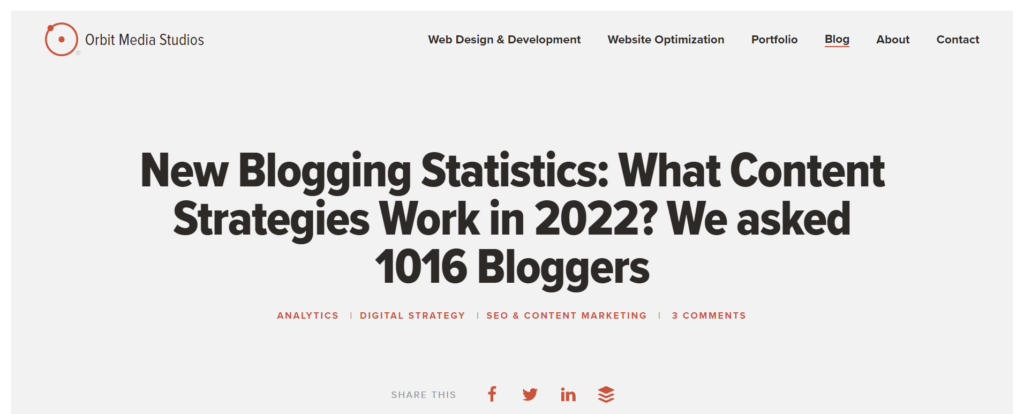
OrbitMedia’s annual blogging statistics survey illustrates a perfect example of how surveys can help build links. Each year since 2014, Orbit Media has surveyed over 1000 bloggers to gain insights into blogging best practices related to writing blog posts. The analysis presents up-to-date trends in blog post types (lengths), promotional methods (positions like images and headings), and other informative aspects. The survey has generated numerous backlinks because of its unique data-driven insights regarding the blogging industry.
Tips for Using Surveys as Link-Building Strategies
Here are a few tips to enhance your link-building efforts through surveys:
- Keep your audience in mind while designing survey questions—relevancy and usefulness are key.
- Use effective outreach marketing tactics to reach out to influencers who may share and link back to the study.
- Cite credible sources when crafting survey-based content and be transparent about the methodology employed.
- Keep your survey up-to-date by regularly updating it or releasing annual editions with new findings.
By creating engaging surveys, you’re offering fresh insights into trending topics that other websites will readily invest their time sharing, thus generating high-quality backlinks for your site. This proactive approach sets savvy marketers apart from others relying on passive methods of link acquisition alone, such as submission directories(content published) or spammy practices(bad inbound requests).
Strategy 19: Create Interactive Content [with Example]
Creating interactive content for your audience is one of the most successful link-building strategies. This approach increases engagement and makes it more likely for other websites to link back to you. Among various types of interactive content, quizzes, and tests are particularly captivating and shareable.
Quizzes and Tests
Creating quizzes or tests can effectively increase your reach, as they often compel users to share their results on social media platforms – this promotes brand visibility and encourages backlinks from other relevant sites discussing the quiz or test. Here are a few tips on how to create engaging quizzes and tests:
- Choose Relevant Topics: Make sure the subject matter relates to your industry or niche. Doing so attracts targeted prospects who will find value in answering the questions and sharing their results.
- Be Creative in Design and Delivery: Ensure your quiz or test is visually appealing, user-friendly, and easy to navigate. This will make it more enticing for people to participate.
- Encourage Sharing: Motivate participants to share their results with others through social media buttons or embeddable widgets tailored for website placement.
- Analyze Results: Use analytics tools to track user interactions with your quizzes or tests; this can help you understand which aspects have successfully driven backlinks and engagements.
Successful Example: Moz’s SEO Expert Quiz
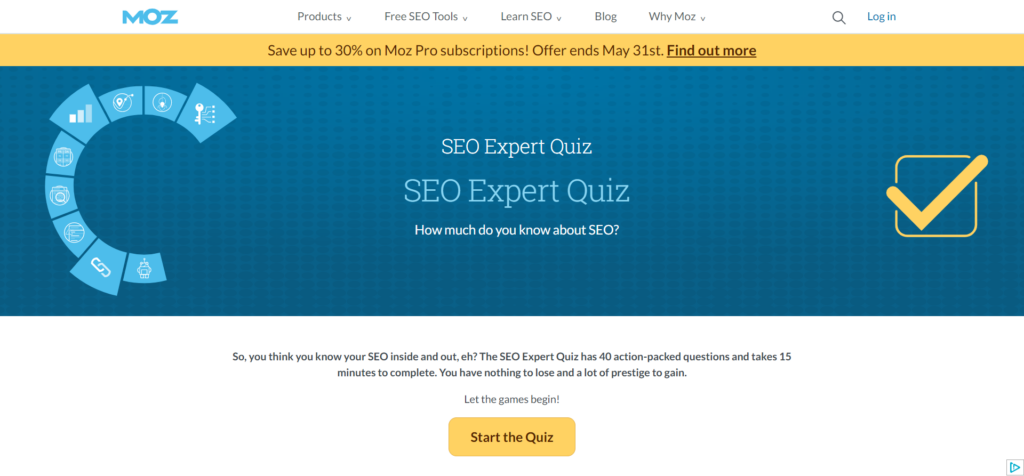
A prime example of a highly effective interactive content piece is Moz’s SEO Expert Quiz. This quiz evaluates an individual’s knowledge of search engine optimization concepts within a fun and challenging format. As many professionals take pride in their expertise, this well-designed quiz has garnered substantial attention, leading numerous individuals to share their scores while generating valuable backlinks for Moz.
In conclusion, offering interactive content like quizzes and tests presents a powerful link-building strategy worth considering. It drives engagement among target audience members and potentially leads to a surge in backlinks when participants share their results on various online platforms.
Strategy 20: Debunk Myths

One unique and effective link-building strategy is to debunk myths or misconceptions within your industry. This approach sparks conversations and debates, leading others to share your content as a reference. By providing well-researched and factual information, readers will see you as an authority on the subject matter, which can lead to valuable do-follow backlinks.
Create Something Controversial
While creating controversial content can be risky, it can bring significant attention and engagement to your website or blog if executed correctly. Here are some tips for crafting content that debunks myths and encourages conversation:
- Choose a specific niche topic related to your industry.
- Research the most common myths, misconceptions, or debated topics in that field.
- Gather compelling facts from reputable sources that disprove these beliefs.
- Present logical arguments backed by evidence when addressing each myth.
- Maintain a balanced tone and avoid offensive language; always remain professional.
- Encourage reader interaction by asking questions and requesting feedback.
Creating provocative content may garner considerable attention but implement this tactic judiciously – controversy for its own sake does not add value nor strengthen your brand reputation.
Remember to use relevant keywords throughout your article.
You can increase its reach even further by taking advantage of social media channels and promoting your myth-debunking article there. Users who find value in shared information will likely cite or reference your work in their blogs or websites, effectively generating organic backlinks. Successfully debunking myths can establish your expertise and cement your standing as a reliable source of knowledge within your industry.
Link Building Best Practices
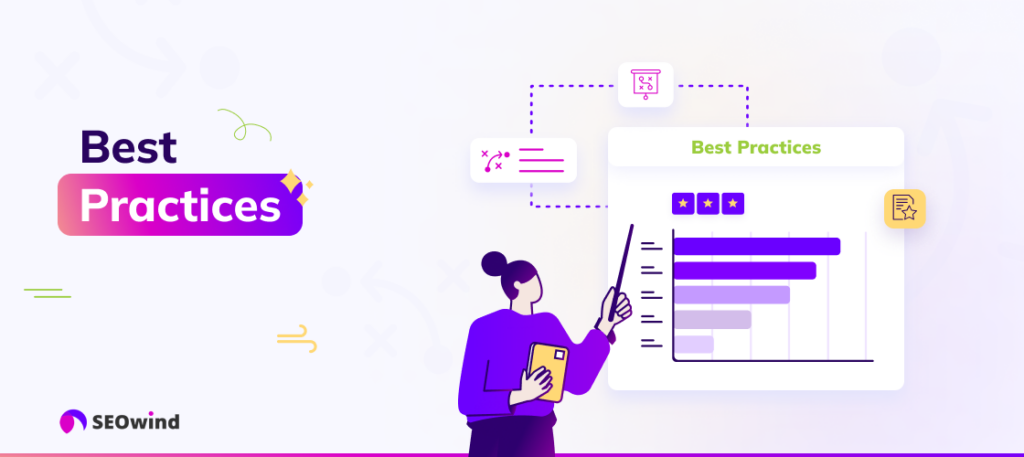
Link building can be time-consuming and challenging, but if done correctly, it will pay off by improving your website’s search engine rankings. To ensure you’re following the right path, here are some link-building best practices that will help guide your efforts and ensure long-term success:
- Focus on quality over quantity: Having a few high-quality backlinks rather than numerous low-quality ones is better. High-quality links often come from authoritative websites that are relevant to your niche.
- Create valuable content: The foundation of any good link-building strategy relies on creating engaging, informative, and shareable content. Producing high-quality content increases the chances of attracting natural backlinks, as people want to share valuable resources with their audience.
- Diversify your link sources: Relying solely on one tactic for obtaining links may appear unnatural to search engines and potentially harm your SEO efforts. A well-rounded approach would include various techniques such as writing guest posts, creating infographic creation, and working on collaborative projects.
- Be proactive in outreach: Build relationships within your industry by connecting with bloggers or influencers interested in sharing or promoting your content; don’t wait for them to stumble upon it.
- Audit your backlink profile regularly: Monitoring your current backlinks ensures you’re aware of any toxic links (spammy or unrelated) that need removal or disavowing via Google Search Console before they negatively impact your rankings.
- Have patience and consistency: Rome was not built in a day – similarly, successful link-building requires consistent effort over an extended period. Don’t expect instant results. Focus on executing targeted strategies while tracking progress.
- Avoid black-hat tactics at all costs: Manipulative strategies like buying links or using private blog networks (PBNs) may yield temporary gains but risk long-term penalties from Google. Stick to ethical, white-hat practices for sustainable success.
- Stay up-to-date with industry trends: SEO and link building constantly evolve as search engines adjust their algorithms in response to user behavior. You can adapt your strategies accordingly and maintain a competitive edge by staying informed on new developments.
By implementing these best practices in your link-building endeavors, you pave the way for increased visibility and organic traffic to your website – allowing you to stay ahead of the competition in 2024 and beyond.
Link Building Tools and Resources
Beginner-Friendly Tools
For those new to link building, several user-friendly tools can help kickstart your efforts:
- Google Search Console: A free tool that provides insights into your website’s search performance and backlink profile.
- Ahrefs Webmaster Tools: Offers a free backlink checker and site audit tool.
- Moz Link Explorer: Provides a limited number of free searches per month to analyze backlinks.
Advanced Link Building Software
For more experienced SEO professionals, these advanced tools offer comprehensive link-building capabilities:
- Ahrefs: Offers in-depth backlink analysis, competitor research, and link prospecting features.
- Semrush: Provides a suite of SEO tools, including backlink analytics and link-building opportunities.
- Majestic: Specializes in link intelligence and offers detailed backlink history and analysis.
Is Link Building Dead?
As a content writer in the digital marketing sphere, it’s not uncommon to come across discussions that question the relevance of link building as an SEO strategy. Some might even argue that link-building is dead. However, I would like to refute such claims and emphasize the continued importance of adopting an effective link-building strategy.
Google has acknowledged that backlinks are among the top factors besides content quality and user experience. It implies that having high-quality, authoritative links pointing to your website can boost your search engine rankings. While the methods of link building may have evolved due to algorithm updates and changing ranking factors, their significance still needs to be improved.
There are several reasons why link-building stays relevant:
- Impact on Search Engine Rankings: As previously mentioned, Google still considers backlinks a strong indicator of a website’s authority and trustworthiness. Therefore, acquiring valuable backlinks is a surefire way to improve your chances of reaching the top positions on SERPs (Search Engine Results Pages).
- Increased Traffic: Earning high-quality links doesn’t only benefit you from an SEO perspective and helps attract referral traffic from other websites. This provides opportunities for reaching new audiences and converting them into potential customers.
- Building Relationships: A sustainable link-building approach often involves establishing relationships with influencers or industry leaders within your niche market. Collaborating with these individuals enables mutual growth while strengthening your credibility among target audiences.
- Brand Visibility & Recognition: Securing links from authoritative sites allows you to showcase your brand expertise, potentially resulting in more awareness and recognition within your field.
That being said, embracing outdated and manipulative practices such as spammy guest posting or buying links can lead to penalties from Google instead of helping you achieve better rankings. To ensure long-term success in today’s competitive online landscape, focusing on proven techniques prioritizing quality and value should be the cornerstone of your link-building strategy.
Measuring Link Building Success
Key Metrics to Track
To gauge the effectiveness of your link-building efforts, monitor these essential metrics:
- Number of new backlinks acquired
- Domain Authority (DA) and Page Authority (PA) of linking sites
- Referral traffic from backlinks
- Keyword rankings for target pages
- Overall organic search traffic growth
Setting Realistic Goals
When setting link-building goals, consider:
- Your industry’s competitiveness
- Your current backlink profile
- Available resources (time, budget, personnel)
- Historical link acquisition rate
Set SMART (Specific, Measurable, Achievable, Relevant, Time-bound) goals for your link building campaigns to ensure realistic and attainable objectives.
FAQs About Link Building Strategies

What are the top link-building strategies?
The most effective link-building strategies often involve a combination of well-executed tactics, such as:
- High-quality content creation and promotion
- Guest blogging on relevant websites
- Infographics and visual content sharing
- Broken link-building strategy
- Personal branding and networking
These approaches effectively increase your website’s visibility and connect with target audiences to create valuable backlinks.
What are some innovative link-building strategies?
Apart from traditional strategies, try experimenting with innovative methodologies to stay ahead of the competition:
- Creating interactive content (e.g., quizzes, calculators)
- Surveys for industry insights
- Cobranded content collaborations with complementary businesses
- Utilizing popular Q&A sites like Quora or Reddit
- Debunking myths or challenging conventional wisdom within your industry
Such approaches can generate attention, encourage sharing, and generate links.
Is link building hard?
Link building can be time-consuming and require continuous effort. It becomes more manageable once you’re familiar with its core techniques. Patience is critical when starting. It may take a while before we see significant improvements in rankings or traffic – but persistence pays off.
How do you run a link-building strategy?
To effectively implement a commitment to repetitive tasks over time will yield desirable results:
- Set clear objectives for your campaign.
- Perform thorough keyword research.
- Identify suitable strategies according to specific goals.
- Execute chosen strategies consistently.
- Analyze site performance data for assessing current practices periodically.
- Make necessary adjustments based on data-driven insights.
By following these steps and monitoring your progress regularly, you can optimize ongoing efforts while raising efficacy levels in domains of interest.
Do I need permission to backlink to another site?
Generally speaking, no explicit permission is needed because linking benefits both parties involved: the one referencing acquires greater credibility with relevant sites and content while receiving traffic through a referral for linked websites. However, be cautious when creating backlinks irrelevantly—doing so may lead to penalties from search engines.
What’s the most common link-building strategy?
Guest blogging remains widely used due to its potential to attract high-quality backlinks through outreach efforts with authoritative websites. Guest blogs deliver value-driven content by leveraging relationships between site owners and bloggers seeking promotional opportunities online.
What’s the best way to find the authority of a website that gives you a backlink?
Several tools facilitate assessing domain authority (DA) or page authority (PA) quickly:
- MozBar: A browser extension provided by Moz
- SEMrush: Offers comprehensive data on domain analytics
- Ahrefs: Delivers detailed insights related to domain ratings
Monitoring DA or PA can help distinguish between high and low-quality backlink sources, ultimately optimizing your link-building strategies more effectively.


